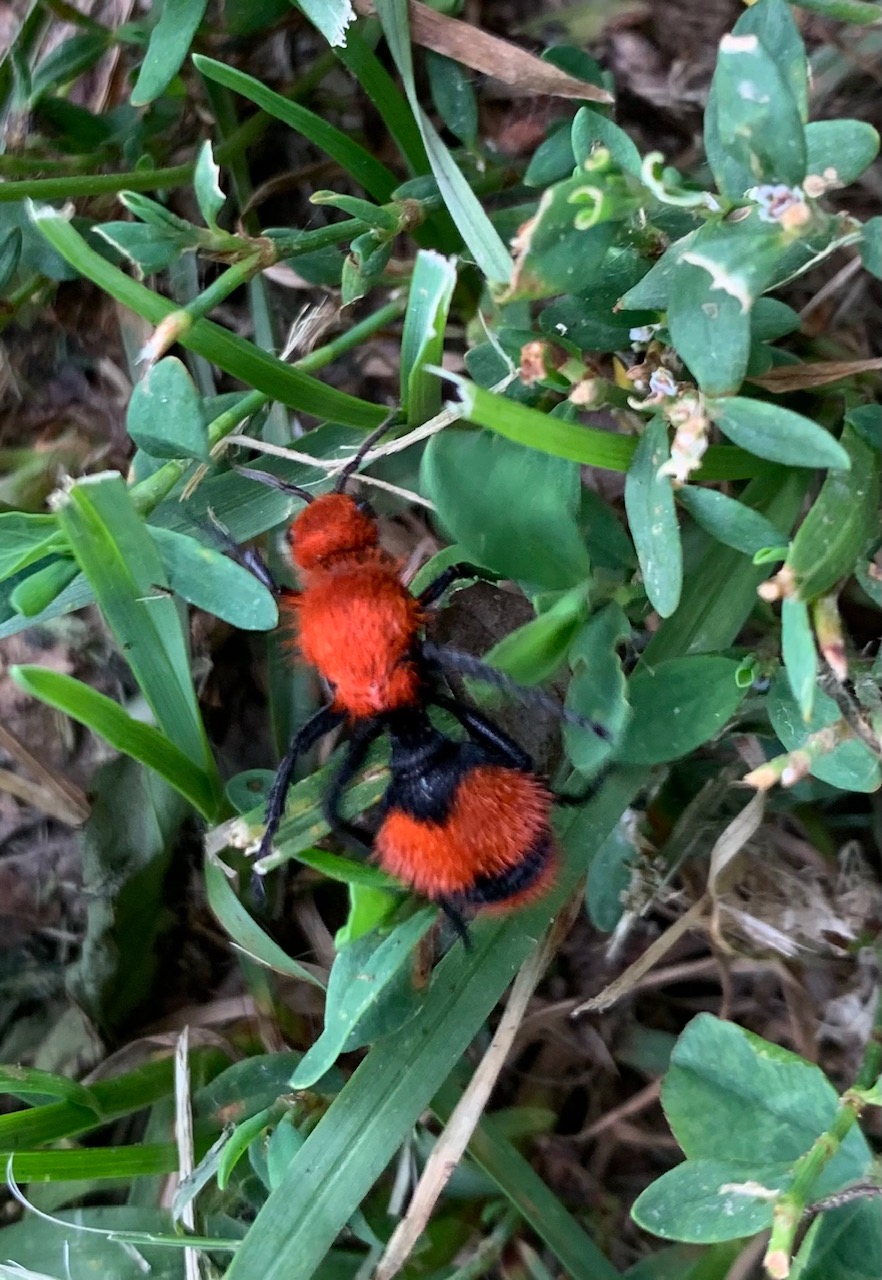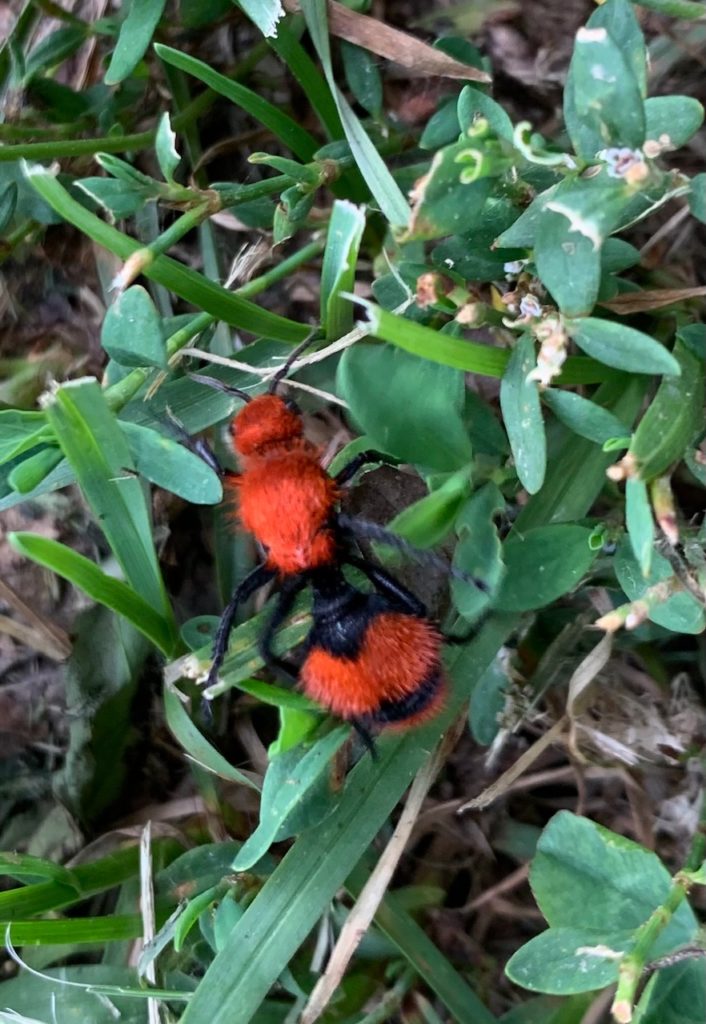I wanted to know the name of every stone and flower and insect and bird and beast. I wanted to know where it got its color, where it got its life – but there was no one to tell me. ~George Washington Carver
I get curious about things I see out in the world of nature and since we now have these computers we carry around in our pockets (phones) that can answer a zillion questions in no time flat, I can usually find out some pretty interesting stuff.
Take the red velvet ant that I discovered is also called a cow killer ant. That’s certainly a name that will make you sit up and pay attention. I didn’t know that name when I was a kid and saw my first red velvet ant. I was entranced because the bug is very attractive. I don’t know whether someone older was there to warn me not to pick it up no matter how pretty it might be or if I was just too scared to pick up any bug, but I didn’t pick it up even though I really wanted to stroke it to see if it was as soft to the touch as it looked. Had someone told me it was a cow killer, I would have no doubt given it a wider berth than I did. Instead I remember following it as it scooted away to wherever it was going.
Since then, I haven’t seen a lot of these guys. The ant is not the giant ant its name suggests. They are actually parasitic wasps. The female red velvet ant digs down into a wasp burrow or ground bees’ nest to lay her eggs. When the eggs hatch into legless grubs, they make short work of the host’s pupae or larvae, and then go through several stages before they become the red velvet ant. They are called ants, well, because the females look like very large ants. The males of the species look similar to the females except they have wings. The males don’t have a stinger like the female. They are able to fly away from danger. As often is the case in nature, the bright red of the red velvet ant is a way of warning predators that they really should hunt something else to eat.
Without wings like the male, the female has to run away from danger, but it can move pretty fast. If it can’t run away, the female stands ready to aggresively fight any predators. I spotted the one in the picture in the backyard last week. I had to do some fast camera focusing to try to catch the picture. At one time the ant/wasp crawled under Marley. I was hoping the thing wouldn’t sting him before I managed to convince Marley of the necessity of moving.
When I came in and looked up about the red velvet ant, I was really glad I hadn’t tried to get the creature to crawl on my hand for a better picture. I was also glad the ant hadn’t decided to sting poor Marley. While the cow killer name is an exaggeration, Marley is a lot smaller than a cow! All ended well with me a picture and Marley sting free.
Here are a couple of interesting facts I discovered.
- The red velvet ants’ sting has mildly toxic venom that causes intense pain in humans and other animals. Although their sting is not fatal for humans, dogs, and cows, the pain it causes has earned them the bad reputation of being ‘cow killers’.
- Since red velvet ants have a wide range of defense mechanisms, ranging from a hard exoskeleton, painful sting, warning coloration, loud squeaking, and a smelly chemical deterrent, researchers consider them to be “basically invincible”.
Hmm, if I’d known about the loud squeaking, I might have poked the ant with a stick or something. But that intense pain didn’t sound good at all. Prefer to avoid that for sure. Best to just let the lady in red go on her way in the grass to whatever she had in mind to be next.
Do you like learning about nature’s bugs and bees, flowers and trees?



Comments 16
Nature is very interesting. It seems every creature has it’s own, sometimes unique line of defense. Some things might sting, some have a bad scent, some fly or run away, some bite, some have sharp claws, and some blow up to look bigger and more fierce. It’s all just amazing to me.
Author
You are so right, Connie.
All things bright and beautiful
All creatures great and small
All things wise and wonderful
‘Twas God that made them all.
And He made them unique with a way to survive.
Absolutely! Thanks Teacher
Author
It’s easy to teach when you have such great students, Amy. Glad you liked learning about the red velvet ant that’s not an ant. 🙂
Do you like learning about nature’s bugs and bees, flowers and trees?
OH YES!
Author
So glad you enjoyed my nature post, Bettie. I like to explore some of the rarities of nature or not so rare too.
Really interesting. I’ve never seen them. Plenty of spotted lantern flies now though.
Author
Interesting, Birdie. I had to look it up to see what a spotted lantern fly was. Don’t think I’ve ever seen one of those.
What fascinating information about the red velvet ants and a fabulous photo! Who would have known that this wasp can make loud squeaks! I do love learning new things about nature–especially what’s in my own yard.
Author
Nature is amazing, Suzanne, and it’s fun to be able to look things up so easily to find out more about them. You know, I wonder if there’s even a recording of that squeak. I know you can pull up bird songs and calls. Why not wasp or ant sounds? 🙂
I don’t see those scary critters very often, but when I do I go the opposite direction. I looked it up a few years ago, read the word “wasp” and decided I wanted no part of them. That’s a great shot of it….you’re braver than I am getting that close, and thinking about touching it. Yikes! I’m glad you and Marley are sting free.
Author
Well, I considered touching it before I looked it up and heard about its “cow killer” sting, Lavon. But I was smart enough not to get too close and although it crawled under Marley, I guess it didn’t feel like stinging anything.
Thank you for sharing that fascinating info. I’ve never seen nor heard of the red velvet ant. I wonder why it’s called “ant” but maybe because the lack of wings. It definitely looks like a wasp, not an ant. Anyway, thanks. I love learning new things.
Author
I guess crawling around in the grass made it seem more like an ant than a wasp, Lee. But names of various creatures can be interesting as one wonders why they are named whatever. The red velvet ant is very eye catching because of its bright color. Stands out in the grass when you do happen to see one.
I enjoy learning about new things.I also did not know about the loud squeaking. I have only seem a few of the cow killers in my lifetime.
Author
I still can’t confirm or deny that loud squeaking, Lisa, but I would be interested to hear it. Maybe I’d have to see it fighting some predator after it. I haven’t seen many of them either, but now I’ll know for sure to let them go on their way.